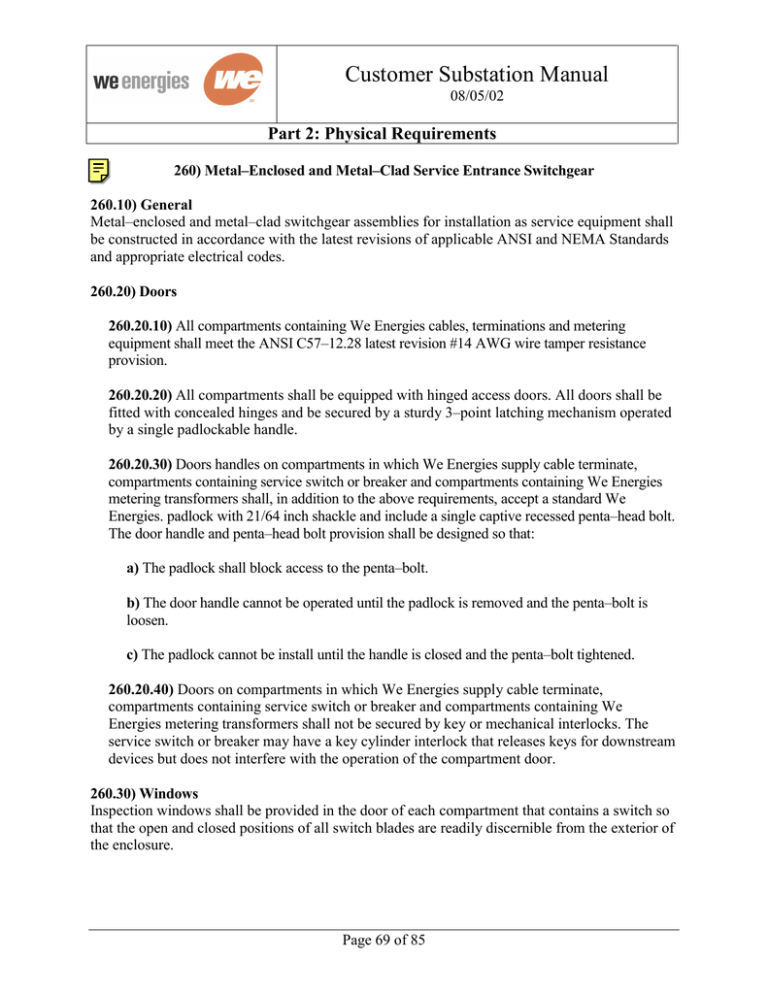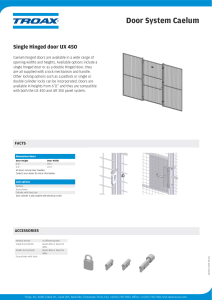260 - We Energies
advertisement

Customer Substation Manual 08/05/02 Part 2: Physical Requirements 260) Metal–Enclosed and Metal–Clad Service Entrance Switchgear 260.10) General Metal–enclosed and metal–clad switchgear assemblies for installation as service equipment shall be constructed in accordance with the latest revisions of applicable ANSI and NEMA Standards and appropriate electrical codes. 260.20) Doors 260.20.10) All compartments containing We Energies cables, terminations and metering equipment shall meet the ANSI C57–12.28 latest revision #14 AWG wire tamper resistance provision. 260.20.20) All compartments shall be equipped with hinged access doors. All doors shall be fitted with concealed hinges and be secured by a sturdy 3–point latching mechanism operated by a single padlockable handle. 260.20.30) Doors handles on compartments in which We Energies supply cable terminate, compartments containing service switch or breaker and compartments containing We Energies metering transformers shall, in addition to the above requirements, accept a standard We Energies. padlock with 21/64 inch shackle and include a single captive recessed penta–head bolt. The door handle and penta–head bolt provision shall be designed so that: a) The padlock shall block access to the penta–bolt. b) The door handle cannot be operated until the padlock is removed and the penta–bolt is loosen. c) The padlock cannot be install until the handle is closed and the penta–bolt tightened. 260.20.40) Doors on compartments in which We Energies supply cable terminate, compartments containing service switch or breaker and compartments containing We Energies metering transformers shall not be secured by key or mechanical interlocks. The service switch or breaker may have a key cylinder interlock that releases keys for downstream devices but does not interfere with the operation of the compartment door. 260.30) Windows Inspection windows shall be provided in the door of each compartment that contains a switch so that the open and closed positions of all switch blades are readily discernible from the exterior of the enclosure. Page 69 of 85 Customer Substation Manual 08/05/02 Part 2: Physical Requirements 260.40) Detachable Panels 260.40.10) Detachable panels on compartments in which We Energies supply cables terminate, compartments containing service switches or breakers, compartments containing We Energies metering transformers, and compartments containing unprotected bus shall be secured so they cannot be removed from the outside of the compartment. The locking provisions shall not be circumvented. 260.40.20) Panels secured by external fasteners using specialty drivers such as hex, torx, star or similar do not meet the intent of this requirement. 260.50) Screen Doors 260.50.10) All compartments that contain We Energies supply cable terminations, service switches, We Energies metering transformers and feeder fuses shall be equipped with hinged screen doors to isolate all high voltage parts. 260.50.20) Service switch compartments equipped with slide–in isolating barriers shall be provided with hinged split screen doors. a) The upper screen door shall isolate only the portion of the switch above the slide–in barrier. b) The lower screen door shall extend from just below the upper screen door to the bottom of the compartment. c) The arrangement and location of the split screen doors and the isolating barriers shall permit the installation of the isolating barriers when only the lower screen door is open. d) Feeder Switch/fuse compartments shall be equipped with a hinged screen door isolating only the switch. An additional hinged screen isolating the feeder fuses is required unless the compartment door is interlocked to the feeder switch operating handle so that the main door can be opened only with the switch open. 260.60) Slide–In Barriers 260.60.10) The service switch compartment(s) shall be equipped with slide–in barriers whenever the switchgear main bus can be energized from more than one source (i.e. multiple We Energies feeders or a We Energies feeder and customer owned generator feeder). 260.60.20) The slide–in barriers shall insert on insulated rails and slide between the stationary and movable contacts of the disconnect switch. Page 70 of 85 Customer Substation Manual 08/05/02 Part 2: Physical Requirements 260.60.30) Slide–in barriers shall be installable using a shotgun type hotstick. 260.60.40) Slide–in barriers shall be fabricated from fiberglass board material. 260.60.50) When installed the barrier shall not contact live parts. 260.60.60) Provisions to store these barriers, when not in use, shall be provided on the outside of the screen door or on the inside of the compartment door. 260.60.70) Storage of slide–in barriers shall not obstruct the viewing window. 260.70) Insulators 260.70.10) Skirted insulators of appropriate ratings shall be used between any connection of a live part and a grounded surface or between live parts of different phases. 260.70.20) The insulators shall be installed so that water will not pool on the skirts. 260.70.30) The insulators may be made of porcelain, cycloaliphatic epoxy resin or silicone rubber. 260.70.40) Requirements for insulators apply to all insulators on unprotected bus which support: a) Interrupter switches, b) Fuse mountings on the source side of the fuse, c) switch push rods, d) interphase insulators. 260.75) Clearances The minimum clearance of live parts within metal enclosed switchgear shall be as specified below in 260.75.10. Minimum clearance between live parts and insulated barriers shall be as specified in 260.75.20. Page 71 of 85 Customer Substation Manual 08/05/02 Part 2: Physical Requirements 260.75.10) Minimum Clearance of Live Parts (From Table 490–24 of the NEC). Nominal Minimum Clearance of Live Parts Voltage Impulse Withstand Phase–to–Phase Phase–to–Ground Rating B.I.L. (kV) Indoors Indoors (kV) Indoors Inches Inches 2.4–4.16 60 4.5 3.0 7.2 75 5.5 4.0 13.8 95 7.5 5.0 14.4 110 9.0 6.5 23 125 10.5 7.5 34.5 150 12.5 9.5 34.5 200 18.0 13.0 260.75.20) Minimum Clearances from Live Parts to Barriers. System Class Impulse Withstand B.I.L. Minimum Phase–to–Barrier Clearance (kV) (kV) (Inches) 5 60 1.5 15 95 1.5 15 110 2.5 25 125 2.5 29 (26.4kV Nominal) 125 2.5 29 (26.4kV Nominal) 150 2.5 35 150 3.0 35 200 3.0 260.80) Momentary Current Rating The integrated switchgear assembly (interrupter switches, breakers, power fuses, primary bus and enclosure) shall have a momentary current rating equal to or greater than the maximum available short circuit current at the point of application. 260.85) Protective Grounding All compartments which contain incoming line terminations and/or service fuses shall be equipped with protective grounding facilities as described in Section 180. 260.90) Potheads and Other Cable Terminations Adequate space shall be provided in the incoming line terminal compartments for the installation of potheads or other terminators (see Section 200.30 for additional detailed termination requirements). Page 72 of 85 Customer Substation Manual 08/05/02 Part 2: Physical Requirements 260.95) Accessibility to Outdoor Switchgear Outdoor switchgear installations equipped with a weatherproof operating and maintenance aisle shall include provisions to secure at least one entrance door with two padlocks. Removal of either padlock shall be sufficient to gain entry. One of the two padlocks will be furnished and installed by We Energies. The second padlock shall be provided by the Customer. Exception: When Customers provide We Energies keys to their padlock. These keys will be kept in key boxes furnished and installed by We Energies on the Customer’s premises near the switchgear. Page 73 of 85



